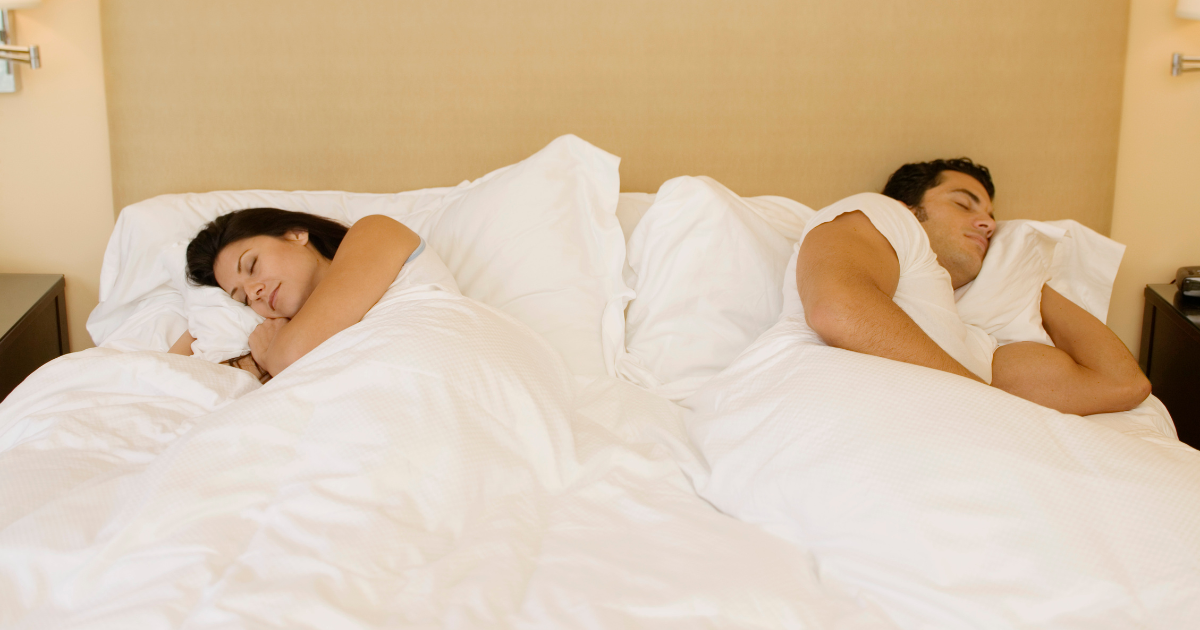Sleep Divorce: What It Is and 5 Alternatives to Try First

More than one-third of American adults sometimes sleep separately from their partners, not because of relationship problems, but in pursuit of better sleep. This practice, commonly known as "sleep divorce," is becoming increasingly mainstream as couples prioritize sleep quality for their health and relationship.
While sleeping apart works for some, it's not the only solution for couples struggling with incompatible sleep habits. This article explores what sleep divorce is, why people consider it, and several alternatives to try before moving to separate beds.
What Is Sleep Divorce?
Sleep divorce occurs when couples choose to sleep in separate beds or bedrooms to improve their sleep quality. Despite the dramatic name, it typically has nothing to do with relationship troubles; it's simply a practical arrangement to ensure both partners get restful sleep.
"I actually recommend that couples sometimes do this, and it doesn't mean that their relationship is in trouble," explains Shelby Harris, a licensed clinical psychologist and director of sleep health at Sleepopolis, in a CNBC interview. "It just means they're actually valuing their relationship and their health as well."
The practice exists on a spectrum. Some couples sleep separately every night, others only on weeknights, and some practice "partial" sleep divorce by starting the night together before one partner moves to another sleeping location.
How Common Is Sleep Divorce?
Sleep divorce is more widespread than many realize. According to a 2023 survey by the American Academy of Sleep Medicine, 35% of American adults sometimes sleep in separate rooms from their partners, specifically to improve sleep. Younger generations appear more open to the arrangement — 43% of millennials report sleeping separately at times, compared to only 22% of baby boomers.
The trend is even influencing the hospitality industry. Hilton's 2025 Trends Report found that 63% of travelers sleep better when alone, prompting hotels to offer more two-bed options for couples traveling together. This shift in hotel accommodations reflects the growing normalization of prioritizing sleep quality, even when it means sleeping apart.
Research suggests very few couples (approximately 2%) maintain permanent separate sleeping arrangements. Most view it as a temporary solution or only sleep apart when absolutely necessary, highlighting that complete sleep divorce is still relatively uncommon as a permanent lifestyle choice.
Also Read: Why Sleep is Important for Your Health
Common Reasons Couples Sleep Apart
Several common issues lead couples to consider separate sleeping arrangements:
Snoring and Sleep-Disordered Breathing
Snoring affects approximately 40% of adult men and 24% of adult women [1] [2]. For many couples, it's the primary reason for sleep separation. When severe or accompanied by gasping or choking sounds, snoring may indicate sleep apnea, a condition that causes breathing interruptions during sleep.
A snoring partner can disrupt the other's sleep multiple times per night, leading to sleep fragmentation and daytime fatigue for both people.
Movement and Restlessness
Some people naturally move frequently during sleep, changing positions as often as 20-40 times per night [3]. Others may have restless leg syndrome or periodic limb movement disorder, or even parasomnias (like sleepwalking), causing involuntary leg or body movements that can wake a sleep partner.
Even getting in and out of bed for bathroom trips can disturb a sensitive sleeper, especially on mattresses that transfer motion easily.
Different Sleep Schedules
Early birds and night owls often struggle to align their natural sleep patterns without disrupting each other. When one partner wants to read or watch TV in bed while the other needs darkness to fall asleep, conflict often follows.
These differences in circadian preference can be genetic and difficult to change, making them a persistent source of sleep incompatibility.
Temperature Preferences
Body temperature regulation plays a crucial role in sleep quality. Core body temperature naturally drops before and during sleep, but the ideal sleeping temperature varies between individuals.
When one person needs extra blankets while another sleeps hot, finding a comfortable compromise can be challenging, leading to poor sleep for both partners.
Also Read: This Common Habit Makes Insomnia Worse
Potential Benefits of Sleeping Apart
For couples with significant sleep incompatibilities, sleeping separately can offer several advantages:
-
Longer, uninterrupted sleep duration
-
Improved daytime functioning and mood
-
Reduced resentment between partners
-
Better management of sleep disorders
-
Customized sleep environments for each person
Drawbacks to Consider
Despite its benefits, sleep divorce comes with potential downsides:
-
Reduced opportunities for physical intimacy and closeness
-
Practical limitations (needing extra space and furniture)
-
Possible feelings of disconnection if not managed thoughtfully
-
Social stigma or judgment from others
-
Additional expense of creating a second sleeping space
5 Alternatives to Try Before Sleep Divorce
Before committing to separate sleeping spaces, consider these less drastic methods that help many couples continue sharing a bed comfortably:
1. Upgrade Your Sleep Environment
A thoughtful bedroom setup can address many common sleep compatibility issues:
-
Invest in a larger mattress: A king-size bed provides approximately 16 more inches of width than a queen, reducing movement transfer between partners.
-
Try a split mattress setup: These allow each person to choose their preferred firmness level while maintaining a unified bed.
-
Use separate bedding: Two twin-size comforters on one bed can solve temperature differences without requiring separate beds.
-
Add a mattress topper to one side: This simple solution can adjust firmness for one partner without replacing the entire mattress.
Dr. Richard Schwab, chief of sleep medicine at the University of Pennsylvania's Perelman School of Medicine, emphasizes the importance of these environmental adjustments: "Small changes to temperature, light exposure, and sound control can make a significant difference in sleep quality for both partners," he notes in a CNBC interview.
Bottom line: Simple bed changes can significantly reduce sleep disruptions while maintaining the benefits of sleeping together.
2. Address Snoring and Sleep Apnea
For many couples, snoring is the primary reason for sleep incompatibility. These methods can help:
-
Try side sleeping: Sleeping on one's side often reduces snoring substantially.
-
Use anti-snoring devices: Options range from nasal strips and dilators to mouthpieces that help keep airways open.
-
Seek medical evaluation: Persistent, loud snoring may indicate sleep apnea, which requires proper diagnosis and treatment.
-
Use sound masking: White or pink noise machines can effectively mask moderate snoring for many light sleepers.
Bottom line: Addressing the root causes of snoring can eliminate one of the most common reasons couples consider sleeping apart.
3. Create a Buffer Zone
Some couples find creative middle-ground solutions:
-
Try the Scandinavian sleep method: One bed frame with two twin mattresses and separate bedding, creating a unified look with individualized sleep surfaces.
-
Use a body pillow between partners: This creates a buffer that reduces movement transfer while maintaining proximity.
-
Consider a "sleep together, apart" approach: Cuddle until one partner falls asleep, then move to separate sides of the bed with minimal disruption.
Bottom line: Creating physical boundaries within a shared bed can provide many benefits of sleeping separately while maintaining closeness.
4. Establish a Consistent Sleep Routine
Compatibility issues often arise when partners follow different sleep schedules:
-
Synchronize sleep-wake times when possible, even on weekends.
-
Create a shared bedtime ritual that signals sleep time for both partners.
-
Limit evening screen time to reduce blue light exposure that can delay sleep onset.
-
Use dimmable lighting to accommodate different bedtime reading preferences.
Bottom line: Aligning sleep schedules and creating consistent routines can reduce disruptions and help couples remain in sync.
5. Support a Healthy Sleep Cycle Naturally
Many sleep compatibility issues stem from underlying sleep quality problems. Addressing these can reduce sensitivity to partner disruptions and promote deeper sleep for both people:
-
Try relaxation techniques like deep breathing or progressive muscle relaxation before bed.
-
Consider a plant-based sleep aid without melatonin, which can cause grogginess or dependency when used regularly.
-
Avoid alcohol before bed, which fragments sleep and often worsens snoring.
-
Maintain consistent exercise habits, but complete workouts at least 1-2 hours before bedtime.
Products like Sip2Sleep® provide natural sleep support through a combination of Montmorency tart cherry extract and Rafuma leaf, both known for their sleep-promoting properties. Unlike melatonin supplements and OTC sleep aids, which can cause morning grogginess or disrupt your body's natural melatonin production, these plant-based ingredients work gently to support sleep quality without side effects.
The sublingual delivery method allows these natural compounds to enter the bloodstream quickly, helping reduce nighttime restlessness and anxiety that can make couples more sensitive to each other's movements. By supporting deeper sleep for both partners, natural sleep aids can help couples remain compatible even with minor sleep disruptions.
Bottom line: Supporting healthy sleep biology can reduce sensitivity to partner disturbances and help both people achieve deeper sleep without separation.
Also Read: Can't Sleep? Discover Why Sip2Sleep® Works Better Than Melatonin
When to Consider a Sleep Divorce
If you've tried multiple alternatives without improvement, a sleep divorce might be worth exploring. Signs it might be right for you include:
-
Chronic sleep deprivation affects health and daytime functioning
-
Relationship tension specifically related to sleep issues
-
Sleep disorders that require specialized sleeping arrangements
-
Significant, unresolvable differences in sleep preferences
Remember that sleep divorce exists on a spectrum. Options include:
-
Temporary separation during high-stress periods or illness
-
Partial week arrangements (together on weekends, apart on work nights)
-
Different rooms but same bedtime routines to maintain connection
-
Starting together, finishing apart to balance intimacy and sleep quality
The Bottom Line
Sleep divorce is increasingly common and can be a healthy choice for some couples. However, before moving to separate beds, consider trying bed changes, addressing specific issues like snoring, creating buffer zones, establishing consistent routines, and supporting healthy sleep biology naturally.
Many couples find that a natural sleep aid like Sip2Sleep® provide enough improvement to make continued bed-sharing comfortable, preserving both quality sleep and nighttime togetherness.
What matters most isn't whether you sleep together or apart, but that both partners get the rest they need while maintaining a connected, supportive relationship.
Frequently Asked Questions
Does sleeping apart mean our relationship is in trouble?
No. Sleep researchers emphasize that sleeping arrangements have little correlation with relationship satisfaction. Many couples who sleep apart report greater relationship satisfaction because both partners are well-rested and less irritable.
How common is sleep divorce?
According to the American Academy of Sleep Medicine's 2023 survey, 35% of American adults sometimes sleep separately from their partners, specifically to improve sleep quality.
Will separate sleeping arrangements affect intimacy?
Not necessarily. Many couples who sleep apart make a point of creating intentional intimacy time, including cuddling before separating for sleep. The quality of interaction often improves when both partners are well-rested.
How do we know if we should try sleeping apart?
Consider a sleep divorce if: 1) you've tried multiple alternatives without improvement; 2) one or both partners consistently wake unrefreshed; 3) sleep deprivation is affecting health or daytime functioning; or 4) relationship tension stems specifically from sleep disruptions.
What's the best alternative to completely separate beds?
Before full separation, most sleep experts recommend trying: larger mattresses, separate bedding systems, addressing specific issues like snoring, creating consistent sleep routines, and using natural sleep aid products (such as Sip2Sleep®) to improve overall sleep quality and reduce sensitivity to disruptions.
References
-
Wali SO, Abaalkhail BA. Prevalence and predictors of habitual snoring in a sample of Saudi middle-aged adults. Saudi Med J. 2015 Aug;36(8):920-7. doi: 10.15537/smj.2015.8.11848. PMID: 26219441; PMCID: PMC4549587.
-
Ah-See KW, Stewart M, Banham SW, Robinson K, Carter R, Wilson JA. Systematic analysis of snoring in women. Ann Otol Rhinol Laryngol. 1998 Mar;107(3):227-31. doi: 10.1177/000348949810700307. PMID: 9525244.
-
Wilde-Frenz J, Schulz H. Rate and distribution of body movements during sleep in humans. Percept Mot Skills. 1983 Feb;56(1):275-83. doi: 10.2466/pms.1983.56.1.275. PMID: 6844073.







